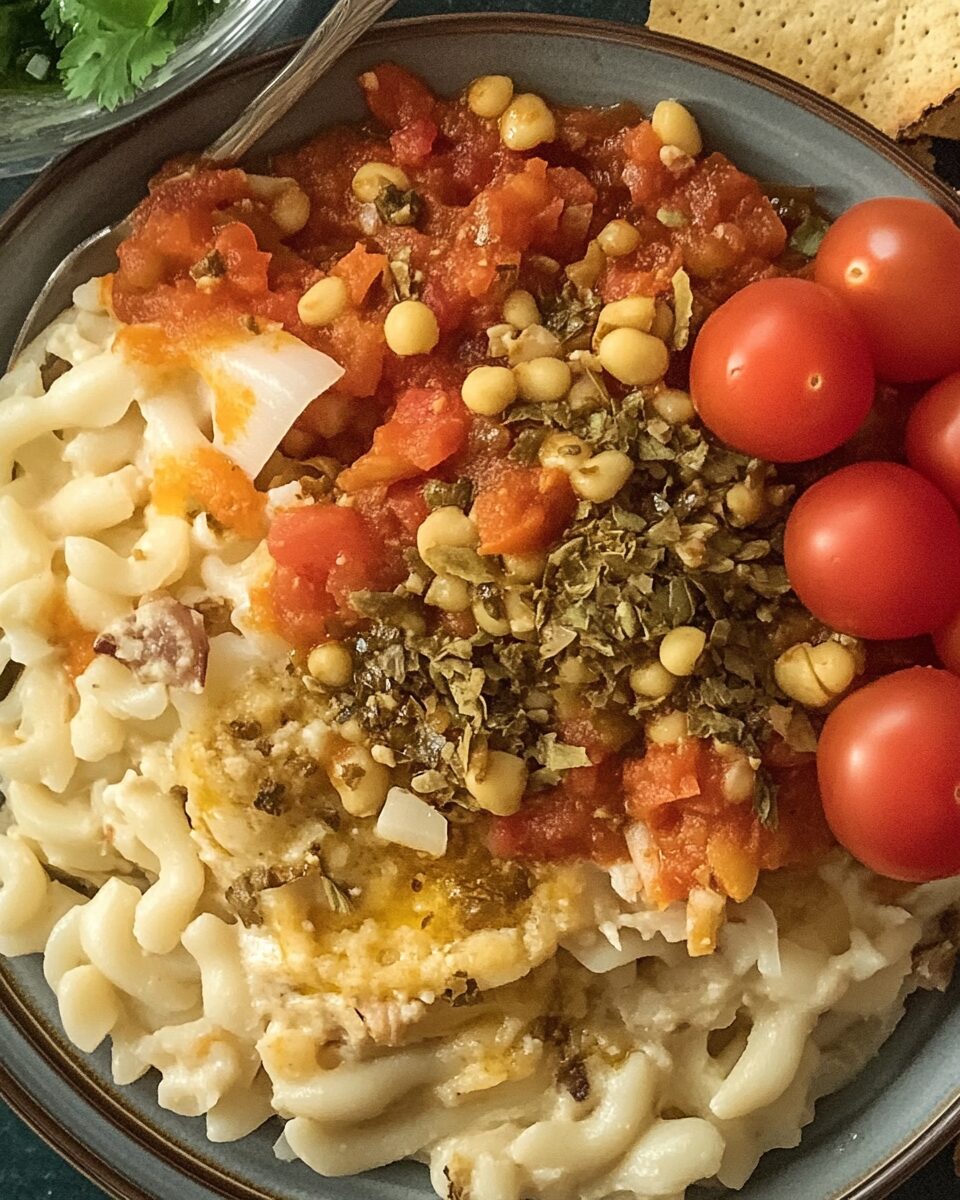Egyptian Koshary is a beloved street food and national dish of Egypt. This hearty and flavorful meal consists of rice, lentils, and pasta, topped with a tangy spiced tomato sauce and crispy fried onions. It is a delicious and satisfying vegetarian dish that showcases Egypt’s rich culinary heritage. Koshary is commonly enjoyed as a filling lunch or dinner and is loved for its unique combination of textures and bold flavors.
Full Recipe:
Ingredients
- 1 cup rice
- 1 cup brown lentils
- 1 cup elbow macaroni
- 2 cups chickpeas, cooked
- 2 large onions, thinly sliced
- 3 tablespoons vegetable oil
- 1 teaspoon salt
- 1 teaspoon ground cumin
For the Tomato Sauce:
- 2 tablespoons olive oil
- 4 cloves garlic, minced
- 1 teaspoon ground coriander
- 1 teaspoon red pepper flakes (optional)
- 2 cups tomato sauce
- 1 tablespoon vinegar
- Salt and pepper, to taste
Directions
- Cook the lentils in a pot of boiling water until tender, about 20-25 minutes. Drain and set aside.
- Cook the rice according to package instructions.
- Cook the elbow macaroni until al dente, drain, and set aside.
- In a large skillet, heat vegetable oil and fry the onions until crispy and golden brown. Remove and drain on paper towels.
- In a saucepan, heat olive oil and sauté garlic with coriander and red pepper flakes. Add tomato sauce, vinegar, salt, and pepper. Simmer for 10 minutes.
- To serve, layer the rice, lentils, and pasta on a plate. Top with chickpeas, tomato sauce, and crispy fried onions.
Nutrients
Calories: 420
Total Fat: 10g
Saturated Fat: 1.5g
Cholesterol: 0mg
Sodium: 380mg
Total Carbohydrates: 70g
Dietary Fiber: 10g
Sugars: 6g
Protein: 15g
The History of Koshary
Koshary has its roots in the streets of Cairo and the broader Egyptian culture, and it is said to have been influenced by a variety of culinary traditions. Although its origins are debated, Koshary is believed to have been introduced to Egypt by Indian and European traders during the 19th century. The dish was likely an adaptation of the British “curry rice” or the Indian “khichdi,” both of which feature rice, lentils, and spices. Over time, the dish evolved to incorporate Egyptian flavors and ingredients, creating the unique version we know today.
In Egypt, Koshary became a popular meal during times of economic hardship due to its low cost and ability to feed large families. The dish is particularly well-suited for street food vendors, and it’s not uncommon to see a Koshary stand on nearly every street corner in Egypt. The dish became synonymous with everyday life in Egypt, especially as an affordable meal option for the working class. Its widespread popularity in Cairo and other cities highlights its cultural significance and its role in bringing together people from all walks of life.
What Makes Koshary Special?
What makes Egyptian Koshary stand out is the way in which the ingredients work together to create a satisfying meal. At its core, Koshary is a simple dish consisting of rice, lentils, pasta, and chickpeas. The addition of crispy fried onions and a rich tomato sauce gives the dish depth and complexity, both in flavor and texture.
One of the defining characteristics of Koshary is its balance of textures. The soft, fluffy rice and tender lentils provide a comforting base, while the pasta adds an additional layer of texture and a bit of chewiness. The chickpeas add a mild creaminess, and the crispy fried onions on top give the dish a satisfying crunch that contrasts beautifully with the other components. The tomato sauce is tangy and slightly sweet, adding a burst of flavor that ties the whole dish together.
In addition to its flavors, Koshary is an incredibly nutritious dish. Packed with carbohydrates from the rice, pasta, and lentils, it provides a hearty and filling meal. The addition of chickpeas gives it a boost of plant-based protein, while the fried onions add a touch of richness. When served with a side of pickled vegetables, Koshary becomes a complete meal that is both delicious and nourishing.
How to Serve Koshary
Koshary is traditionally served as a main dish, and it’s commonly enjoyed as a hearty lunch or dinner. It is typically presented in a large bowl or on a plate, with the layers of rice, lentils, pasta, and chickpeas arranged in a pleasing manner. The fried onions are generously sprinkled on top, adding both visual appeal and crunch. The tomato sauce is poured over the top just before serving, allowing it to soak into the other ingredients and infuse them with flavor.
In Egypt, Koshary is often accompanied by a variety of sides and condiments that enhance the meal. One of the most common accompaniments is a side of pickled vegetables, which provides a sharp contrast to the rich and savory flavors of the Koshary. Pickled cucumbers, turnips, and carrots are common choices, and they help balance the meal with their tangy and sour notes. Additionally, some people like to drizzle a bit of hot sauce or chili oil on their Koshary for an extra kick of heat.
Koshary is also often served with a simple salad of tomatoes, cucumbers, and onions, providing a refreshing contrast to the heavier main dish. The meal can be eaten with flatbread, which is used to scoop up the ingredients or to accompany the meal in a more traditional style. Whether served with sides or on its own, Koshary is a complete and satisfying dish that can be enjoyed at any time of day.
The Nutritional Benefits of Koshary
Egyptian Koshary is not only a flavorful and satisfying meal, but it also offers a range of nutritional benefits, thanks to the combination of ingredients used in the dish. The primary components—rice, lentils, pasta, and chickpeas—are rich in carbohydrates, making Koshary a great source of energy. These ingredients also provide fiber, which is important for digestive health and helps keep you feeling full longer.
The lentils in Koshary are an excellent source of plant-based protein, making the dish a great option for vegetarians and vegans. Lentils are also rich in iron, which is important for maintaining healthy red blood cells and supporting overall energy levels. Chickpeas, another key ingredient in Koshary, are also high in protein and fiber, and they are packed with essential vitamins and minerals, such as folate, manganese, and potassium.
The fried onions, while adding richness and flavor to the dish, also provide a small amount of antioxidants, which are beneficial for fighting inflammation and supporting overall health. The tomato sauce, made with garlic and olive oil, is rich in vitamins A and C, which are essential for immune health and maintaining healthy skin.
While Koshary is a nutritious dish, it is also relatively high in calories due to its carbohydrate content. For those who are watching their calorie intake, the dish can be made lighter by using less oil for frying the onions or by reducing the amount of pasta. Additionally, serving Koshary with a side of fresh vegetables or a simple salad can help balance the meal and increase its overall nutritional value.
Modern Variations of Koshary
Although traditional Egyptian Koshary remains a beloved dish, many home cooks and chefs have found creative ways to adapt the dish to suit modern tastes and dietary preferences. Some variations of Koshary include the addition of vegetables, such as sautéed spinach, eggplant, or bell peppers, which add both color and nutritional value to the dish.
For a healthier twist, you can swap out the white rice and pasta for whole grains like quinoa or whole wheat pasta, which offer more fiber and nutrients. Additionally, some people choose to bake the onions instead of frying them, which reduces the overall fat content of the dish while still providing a crunchy topping.
For those who prefer a spicier version of Koshary, you can experiment with different spices and seasonings in the tomato sauce or add chili peppers to give the dish a bit of heat. Some people also like to add a dollop of yogurt or tahini on top of their Koshary, which adds a creamy element and further enhances the dish’s flavor profile.
Conclusion
Egyptian Koshary is a dish that encapsulates the heart and soul of Egyptian cuisine. With its combination of rice, lentils, pasta, chickpeas, and crispy onions, Koshary is a meal that is as satisfying as it is delicious. It reflects the resourcefulness and creativity of Egyptian cooks, who have turned simple ingredients into a meal that is beloved by people of all ages and backgrounds.






